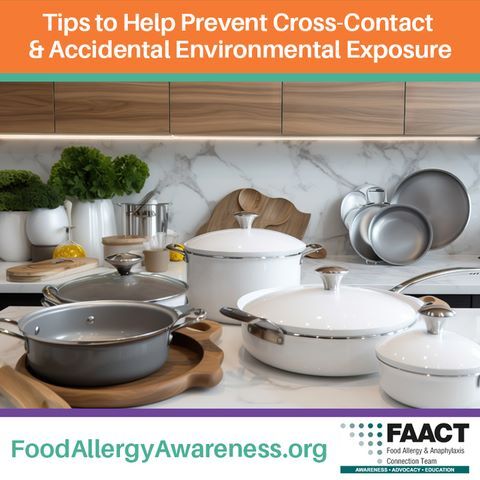Cross-Contact

How To Prevent Cross-Contact and Accidental Environmental Exposure
Cross-contact and environmental exposure are often cited as top concerns for families managing food allergies. Cross-contact can occur through incidental contact with utensils, pots and pans, and preparation surfaces. Environmental exposure can occur through contamination of surfaces and are widely thought to occur through inhalation of allergen. This is a particular concern at school and on airplanes.
The good news is that allergens can be readily cleaned from hands and body parts, cookware and utensils, and environmental surfaces. Following are helpful tips to prevent environmental contamination:
- When cleaning surfaces (such as desks, counters, tables, airline seats or tray tables, etc.), use a wipe that contains a commercial detergent (e.g., Clorox®, Lysol®, etc), or apply a spray-on detergent (e.g. Formula 409®, Fantastic®, Windex® Multi-Surface, etc.) and vigorously wipe the area that has come into contact with the allergen. In a 2004 study, dish soap did not remove peanut allergen.
- Run contaminated pots, pans, and utensils through a normal dishwasher cycle or wash them by hand with hot, soapy water and scrub the surfaces thoroughly. Use a sponge, scouring pad, or dish rag that has not come into contact with the allergen. Rinse and dry thoroughly with a clean towel. Avoid just wiping down a knife or common utensil with a rag after touching an allergen (a common practice at sandwich shops).
-
For washing hands or face, use warm/hot, soapy water or a commercial “tidy” wipe. Hand sanitizing gel is not sufficient to remove allergens. This is important in the healthcare setting, as most healthcare facilities have moved to near-exclusive use of hand sanitizing gels for infectious purposes.
Additional ways to avoid cross-contact when dining out and ordering food:
- Before dining out, check the restaurant’s Web site to determine if there are potential safe foods and whether ingredients are listed on the menu. Ask to speak to a manager or chef in advance to discuss your concerns.
- When seated at a table, use a commercial-detergent-containing wipe to wipe down the eating area and chair that the food-allergic individual may come in contact with. If menus are re-usable, wipe these down as well before allowing the food-allergic individual to touch them
- ALWAYS bring written instruction cards that include your or your child’s allergens, and ask to speak with the chef or manager (even if you spoke to them in advance). Specifically ask for separate utensils, pots/pans, plates, and preparation surfaces that have not come in contact with the allergen(s) in question.
- If an item is served that you know or suspect contains the allergen in question, ask for a separate dish to be brought out and HOLD ON TO YOUR DISH until a new one is prepared. Never allow the item to be brushed off, picked out, or “eaten around” since allergens can easily rub off and contaminate the dish even after the item has been picked off or brushed off.
- Even if you have eaten at a particular establishment before, double check the ingredients and preparation. Recipes change. Don’t assume anything is safe until you verify that it is.

.jpg)
